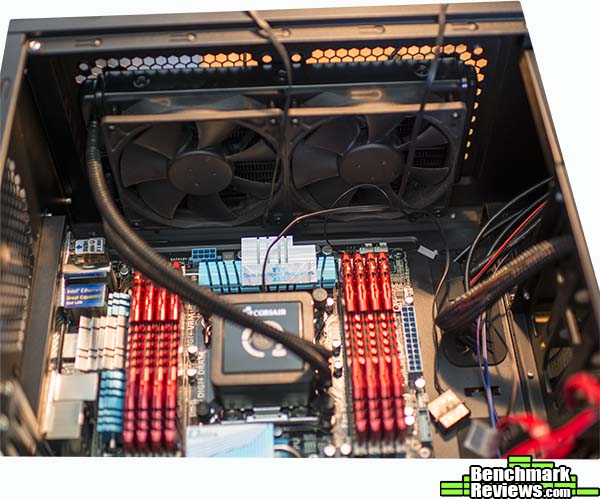PAGE INDEX
Antec P100 Testing and Results
Testing Methodology
The Antec P100 was used to rebuild a three-year-old x79-based system whose enclosure had effectively disintegrated from the rigors of multiple builds.
This particular system is fairly demanding from a space and thermal management perspective. There is a Corsair H100 cooling system for a 4.4GHz overclocked i7, seven hard drives including a PCI based SSD card and two power-hungry dual slot graphics cards. The case that is being replaced has 4 large fans and the H100 cooler for thermal management
The P100 will be evaluated for temperature and acoustic performance once the above components have been installed.
Test System
-
Motherboard: Asus P79 Deluxe
-
System Memory: 64GB
-
Processor: Intel i7-3960X
- CPU Cooler: Corsair H100
-
Audio: External USB
-
Video 1: GEFORCE GTX-TITAN
-
Video 2: GEFORCE GTX-590
-
Disk Drive 1: OCZ RVD3-FHPX4-480G
-
Disk Drive 2:: Samsung 840 EVO 500
- Disk Drive 3: Multiple 3.5′ Hard drives
-
Optical Drive: Samsung Blu Ray
-
Enclosure: Antec P100
-
PSU: Corsair TX850M
-
Monitor: Multiple 1920 X 1200
-
Operating System: Windows 8.1 Pro
Results
The P100 has a spacious interior, although I initially wondered whether it would be able to accommodate the Corsair H100 CPU cooler in the space above the motherboard.
The relatively small 850 W power supply easily fits into the bottom of the case with plenty of room left over. You could easily install some of the largest power supplies in this case without bumping up against the disk drive bays.
It turns out that the Corsair H100 CPU cooler doesn’t even begin to fill up the available space at the top of the P100 case. There’s still plenty of room for cables to push through for power supply connections to the CPU.
The motherboard installed effortlessly thanks to the numerous cable feed through points thoughtfully lined with rubber grommets.
The back of the case provides for plenty of space to route the motherboard power supply cables as well as power and data for the SATA drives. There was no need to apply any force to the back panel when the case was sealed, indicating that the wires fit well inside the wiring side of the P100.
Once the computer was powered up, it was obvious that the extra acoustic padding in the P100 is responsible for a very silent case. Even with the graphics cards under full load from a GPU-based rendering program, the fan noise was minimal.
After several hours of heavy workload with a typical system power dissipation of over 700 W, the motherboard temperature started to creep up above 60 degrees. After installing a second 140 mm fan at the available input position and increasing the fan speed profile, the system temperature remained in the mid 50s.









Most Recent Comments